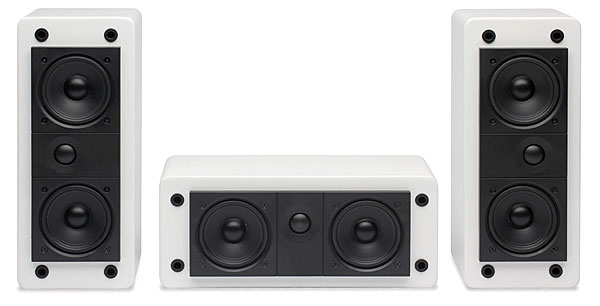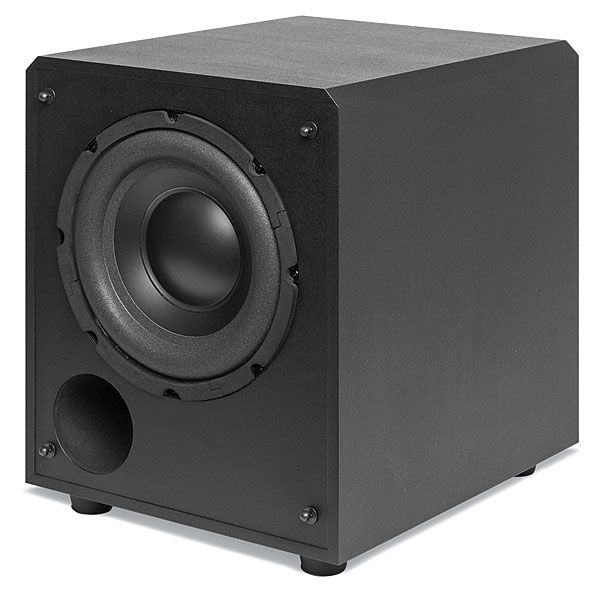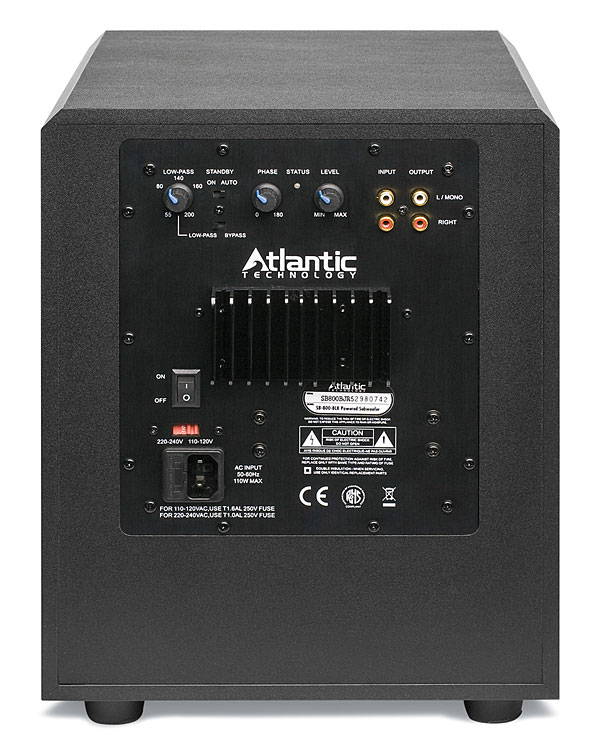Atlantic Technology FS3 and LCR3 Speaker System Review Page 2
I work things like Trumbo (BD, DTS-HD Master Audio) into my viewing regimen because I like quality drama, but this one comes with a juicy score that bravely mingles orchestral jazz with John Cage–like prepared piano. The bar and satellites made the music luscious and colorful, although the bar didn’t quite do justice to the outdoor ambience of a backyard picnic or voices echoing in the halls of Congress. This heightened my anticipation of the grand swap of the bar for three satellites.
The unanalytical bent continued in the self-titled debut album of Crosby, Stills & Nash on vintage vinyl. Operating in two channels, the Atlantic bar favored blending of the three distinctive voices over separation, as though there were a fourth voice in the room—a unique choral voice. The bar’s limited width may have contributed. The bar changed its personality for the individual demands of each song. Stephen Stills’ “Suite: July Blue Eyes” is mixed hot, and the bar didn’t dumb it down: The unified choral voice bounded assertively out of the bar, and the Eastern-flavored acoustic guitar really stung. The bar took the opposite tack with David Crosby’s “Guinnevere”: softly textured, laid-back, and hypnotic, the guitars gently chiming, not biting. Graham Nash’s “Lady of the Island,” a duet with Crosby (the voices separating for a change), was beautifully imaged and highly resolved, and the bar somehow made it surprisingly intimate.
Linn’s surround SACD of Bach Violin Concertos includes two pieces for violin and oboe, in addition to the familiar violin works. (John Butt leads the Dunedin Consort with violinists Cecilia Bernardini and Huw Daniel and oboist Alfredo Bernardini.) This was a surprise. I didn’t expect the initial burst of tone color; the FS3 is truly a high-resolution soundbar (a combination of words you don’t see every day). The bar’s top end was sweet enough to flatter the beautifully recorded period instruments.
Entre Amigos, by Brazilian singer Rosa Passos and jazz legend Ron Carter, is a hybrid SACD from Chesky. The Oppo identified the disc as 5.0, with bass management provided by the receiver. The center channel went unused, leaving the left and right channels to image Passos’ velvety, voluptuous voice and the surrounds to tug it ever so slightly forward. Despite the amount of ambience embedded in the front channels, the bar imaged in a somewhat mono-ish fashion, which again heightened my anticipation of the impending bar/sat swap. While the sub didn’t make Carter’s string bass sound big, it did underpin the articulate attack of his instrument.
Act II: Sats All Around
I replaced the FS3 soundbar with three vertical LCR3 satellites in the front, leaving the other two LCR3s as the side-surrounds. This reshaped the trapezoidal soundfield to something more like a rectangle, though it wasn’t perfectly rectangular; the front speakers were still slightly closer together than the surrounds. But the fronts were toed in, whereas the surrounds fired from the sides. As I replayed the demos, it occurred to me that confirmation bias may have influenced my assessment of how the front satellites would differ from the bar. But some scenes and selections really did feel different.

In the Game of Thrones episode, the outdoor sounds were predictably more open. However, some sounds—like the chuckling brook—weren’t really transformed. A dissonant moment in the score, signifying a mortal threat in the woods, gained drama along with frontal width, as did King Robert’s triumphal entrance into Winterfell and the drums at the Dothraki wedding party. I felt more immersed in a bucolic peasant scene inside castle walls, with milling horses and yipping dogs.
The stairwell chase in Blindsided echoed more dramatically. The gasps of the pursued woman were localized in the center channel, something I hadn’t noticed with the bar but did notice with the more widely spaced sats. Vocal timbre in dialogue was just the same, though. The soundfield was less dense in front, but also less speaker-bound.
When I cued up the delicious orchestral jazz score in Trumbo, the front width expansion was especially gratifying. An orchestra isn’t meant to be confined by the width of the average soundbar. The wistful going-to-prison music, the tense prepared-piano counterpart to the screenwriter’s hunt-and-peck, and especially the snippet of Alex North’s Spartacus score at the movie’s theatrical premiere had not only greater width but also greater emotional impact, once the front soundstage was no longer squished. As with dialogue, instrumental timbre didn’t differ as much.
In some respects, the Crosby, Stills & Nash album was closer to what the artists intended. Several songs have guitars at far left and right, flanking the vocals in the middle. The separation of guitars and vocals was more pronounced. The tight unity of harmonizing voices wasn’t affected in a song like “Suite: Judy Blue Eyes,” where all three are mixed precisely in the middle; I double-checked with headphones to make sure I was hearing it correctly. But in Stills’ “Helplessly Hoping,” which spreads the three voices across the soundstage, greater stereo separation enriched the music.
The Bach violin concertos were more airy. The interaction of instruments and venue was presented more naturally in a roomier soundfield. The violin soloists were better imaged and more distinct. However, perversely, I did miss the bar’s stringent compacting of the front channels, a denser presentation that somehow made the orchestra seem richer and more colorful.
The tasty Passos/Carter duet came through with the same texture but more of the space that Chesky painstakingly captures in its recordings. Front ambience, which had been audible but oddly detached when heard through the bar, was better integrated with the primary vocal and instrumental elements. It also better complemented ambience in the surrounds, eliminating discontinuity between front and back. The soundfield was at its best with the saxophone solo and the cowbell (more cowbell!). I better appreciated the murmuring, rhythmically insistent acoustic guitar when it had more of its own space in the further-flung right channel.
Act III: Second Sub
The last configuration was five LCR3 satellites with two SB-900 subwoofers. My customary single-sub position is between the center and left speakers, so it was aesthetically pleasing to place the second sub between center and right. Other possible placements would be in the front corners; on the front wall, one-quarter to one-third of the way between the side walls; on the side walls, at various points between front and back; and in opposing diagonal corners, one front and one back. These and more are all worth trying if you have a rectangular room with predictable acoustics, but mine is a six-sided room where no two walls are the same length, and I use asymmetrical long-wall speaker placement. Occasionally, an acoustics expert offers to suss out the perfect speaker positioning, then rolls his eyes when I describe the room.

When I repeated the Passos/Carter duet, the first thing I noticed was that the second sub put more bass energy into the room and raised the overall level by the expected 4 to 6 dB. I compensated with a 5-dB reduction in the sub output level from the surround processor. Even with volume corrected, the string bass gained in texture and definition. With one sub or two, bass level varied as I stepped into and out of the room’s standing-wave zone, though the difference was less pronounced with two subs, and I noticed it became even less pronounced (in my room, at least) if I toed out the subs so that their front-firing drivers wouldn’t hit the back wall head-on. It took The Who’s Live at Leeds (CD) to demonstrate the limits of the 3.5-inch drivers in the satellites and the 8-incher woofers in the subs. Drummer Keith Moon’s rolling thunder and bassist John Entwistle’s rumbling commentary needed heavier artillery; I was used to getting more slam out of the 7-inch aluminum woofers and 10-inch flat sub driver of my Paradigm Studio 20 monitors and Seismic 10 sub. Still, the Atlantic system performed decently within its size (and price) limits, and better yet with double subs.
If you want to convince a friend that a sat/sub combo can provide a full musical experience, the Beatles’ Abbey Road (CD) makes a stronger case by placing more bass and drum tone above the crossover. With the drums mixed at hard-right in “Come Together,” having the second sub between the right and center channels produced a better dovetailed sound (though true full-range speakers would be better still). In 1960s and ’70s recordings with drums or bass off to the sides, having a sub no more than a few feet away from the left and right speakers does help, as would a lower crossover point, too.

Although I focused on the flanking-center positions, both subs were on long tethers, and they were light enough to easily move around the room. As I did so, I ran bass sweep tones from the DVE: HD Basics test disc and watched a real-time analyzer running on an iPod touch with thumbtack mic. Because my system’s front left and right corners are nowhere near right-angled walls—which, usually, I’d consider to be an advantage—I didn’t test corner sub positioning, though in a normal room I’d expect to get more (and probably less evenly distributed) bass. I did move the subs to the midpoint of the side walls. This produced as much as 10 dB more bass at the top end of the sub’s range with a 100-Hz crossover. So did diagonal placement, with one sub near the front left speaker and the other near the right side-surround. See our sub measurements for the specifics on anechoic extension.
I concluded that the flanking-center positions were the best choice for my room. It wasn’t the position with maximum room-gain, but the subs had plenty of output. Your situation, of course, will differ, and I haven’t even considered the possible effects of full room EQ. But getting some cheap long cables and experimenting with placement is always well worth the effort. I’ve never heard a system that didn’t benefit from additional subs.
The Atlantic Technology FS3 is a thoughtfully designed, beautifully voiced, hi-res-worthy passive soundbar. It is not only beyond excellent for its price but well into best-in-its-class, I-could-live-with-this territory. If I needed to buy a passive soundbar right now with my own ink-stained pennies, it would be this one. The LCR3 satellites sound just as well rounded, and the SB-900 is a highly tuneful bass maker. Sometimes, reviewing speakers is a burden, because the guests aren’t as good as the stuff that usually sits on my speaker stands. But I never felt the urge to disconnect this system and use my own for off-hours listening—not even when the bar was hooked up. It was that good.




























































